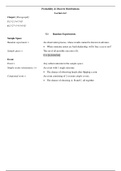Zusammenfassung
Summary Lecture 02: Probability & Discrete Distributions [Week 6]
- Kurs
- Hochschule
- Book
An extensive summary of chapters 5 and 6. Learning material is further clarified with the help of images and symbols to better visualize and understand the learning material.
[ Mehr anzeigen ]




